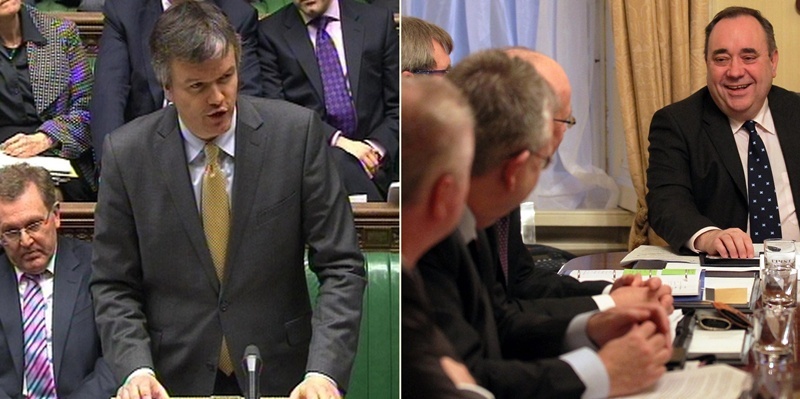Alex Salmond has outlined a timetable for the independence referendum just minutes after the UK Government insisted it would be illegal.
During a day of dramatic developments that left Scotland mired in constitutional chaos he said the poll will be held in autumn 2014.
The First Minister unveiled his timetable for the referendum despite the UK Government outlining a separate and incompatible vision of how the process should proceed.
In a statement at the House of Commons, Scottish Secretary Michael Moore said a referendum conducted from Holyrood would be illegal and struck down by the courts.
He published a consultation paper designed to ensure a ”legal, fair and decisive” referendum could take place on what he described ”the most important decision Scots will take in our lifetime.”
He added: ”The future of Scotland must not be worked out in secret behind closed doors, nor determined by wrangling in the courts. It is my task to ensure that this referendum is made in Scotland, by the people of Scotland, for the future of Scotland.”
But Mr Salmond rejected the Coalition’s intervention and said he would publish his own consultation on the referendum within the next two weeks.
The UK Government proposes a ”Section 30 order” which would require approval at both Westminster and Holyrood to give the Scottish Government the power to deliver the vote.
The process would set terms of reference for the referendum before devolving the responsibility of calling the poll to Edinburgh.
These would include the question asked, who could vote and which organisation would have responsibility for overseeing the referendum.
But the consultation retreated from leaked plans widely criticised to set a time limit on when the poll would take place.
Instead, the question of whether a legal deadline should be attached will not be decided until after the consultation closes on March 9.
Labour branded Mr Salmond’s decision to announce the autumn 2014 date shortly after Mr Moore’s statement a ”panicked response” to the day’s developments.
The First Minister accused the Coalition Government of an ”entirely unacceptable Tory attempt to impose London strings on Scotland’s referendum.”
Continued…
“If you are going to do things properly, allow the proper process to take place, that debate in the way that it must be had, then that is the date we are going to move towards,” he added.
“I can understand that perhaps they have not thought about these things, but they must resist the temptation to try and interfere in Scottish democracy. Let the common sense, the good judgment, of the Scottish Parliament and above all the view of the Scottish people prevail at the end of the day.”
Referring to the proposal for a Section 30 order, Mr Salmond’s spokesman said the Scottish Government would accept such a move provided it came with “no strings”.
He said the SNP administration was “entirely confident” a referendum called by Holyrood would be legal and he urged the UK Government to “reflect, reconsider, rethink and withdraw any attempt to dictate conditions.”
But Downing Street signalled it would be willing to seize control of the poll if the Scottish Government does not sign up to the terms, with the possibility the issue could end up in court.
Scottish Labour leader Johann Lamont called for cross-party talks on the detail of the referendum.
“We need to know that there will be just one question, what that question is and that the Electoral Commission will administer it,” she said.
Scottish Conservative leader Ruth Davidson said “decisive action” by the UK Government had forced Mr Salmond to reveal the date.
“We can discuss times and dates as part of the consultation, but the key issue for me are what is the question and who is the referee?”
Scottish Liberal Democrat leader Willie Rennie warned that Mr Salmond’s announcement did not clear up the legal issue.
The order proposed by the UK Government would require any referendum to be held under the oversight of the Electoral Commission. There would be only one ballot paper offering voters a single choice of independence or remaining part of the UK.
The SNP hope to extend the franchise to 16 and 17-year-olds a group thought more likely to support independence.
North East Fife MP Sir Menzies Campbell said: “The present political, economic and social uncertainty is unacceptable and against the interests of the people of Scotland. An early referendum is essential to resolve this uncertainty and to give Scotland the opportunity to decide its own future.
“If the SNP are so confident why are they so reluctant to put their case to the test? Could it be that the Bravehearts are no longer quite so brave?”
CBI Scotland director Iain McMillan said: “Concern does exist in our membership about the uncertainties arising from the commitment to a referendum and its timing. That is why we have called on the UK and Scottish administrations to work together to ensure that any referendum is held sooner rather than later, to deliver a clear result either for or against independence, and to ensure its legality is put beyond doubt.
“We look forward to responding to the consultation paper after consulting with our members on the detail.”
Photos by PA Wire
